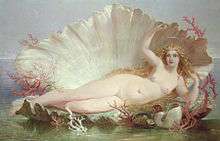Henry Courtney Selous
Henry Courtney Selous (b.Panton Street, Haymarket, London 1803; d.Beaworthy, Devon, 24 September 1890)[1] was an English painter, illustrator and lithographer.

Life
He was the son of Gideon "George" Slous (1777–1839), a Flemish portrait and miniature painter, and a pupil of John Martin who was an important and influential English painter of the 19th century. He was an occupant of Keats House in Hampstead, from 1835 to 1838. Selous had two brothers, Frederick Lokes Slous (the father of Frederick Courteney Selous) and Angiolo Robson Slous, a playwright who wrote True to the Core: A Story of the Armada and whose daughter Alice married the novelist Morley Roberts.[2] He married on 4 March 1837 Emily Elizabeth (d. 1879), daughter of the successful miniature painter Henry Pierce Boneat at St Pancras Parish Church and they had four daughters.[1]
Career

In 1818 Selous entered the Royal Academy Schools and also exhibited his first work, a Portrait of a Favourite Cat (location untraced), at the Academy. He submitted animal portraits for the next three years before embarking on human portraiture. His early works were exhibited under the name Slous, but at some time between 1831 and 1838 he adopted the name Selous.
In the 1840s he began to paint historical subjects, initially inspired by the renewed interest in history painting prompted by the New Palace of Westminster cartoon competition for the designs of frescoes on the new building in 1843. In this he submitted a picture of Boadicea Harranguing the Iceni which won a premium of £200 in 1843. He was aided by the knowledge of mural technique he had acquired by working for a panorama painter. Despite the prize, the picture was criticised by one reviewer because the "violence of the action and dashing lights carry us away like the speech of a mob orator."[3]
He painted historical pieces for the rest of his career, for example Cassio Wounded (1874, location untraced), as well as such works as The Opening of The Great Exhibition (see works, below) recording contemporary events.[4]
Works
- The opening of The Great Exhibition, by Queen Victoria on 1 May 1851 depicts the Archbishop of Canterbury offering the benedictory prayer at the opening ceremony. Sir Henry Cole, the first director of the Victoria & Albert Museum, stands in the group on the right.[5]
- Jerusalem in her Grandeur
- The Glorious Charge of the Heavy Brigade depicts the Inniskilling Dragoons and the Scots Greys during the classic cavalry charge at Balaclava, 1855, location untraced.
- 22 original pen-and-ink drawings to John Bunyan's Pilgrim's Progress, London, 1844 or earlier, 22 original pen-and-ink drawings on wove paper[4]
References
- Nathan Uglow: Selous , Henry Courtney (1803–1890), Oxford Dictionary of National Biography, Oxford University Press, May 2011, accessed 22 Nov 2012
- "Nicola Barton's family tree". Archived from the original on 2011-07-08. Retrieved 2010-10-26.
- Clarke, Guide to the Westminster Frescoes, 1843 p.19
- "Art Market Intelligence website". Retrieved 2008-10-17.
- "Victoria & Albert Museum website". Retrieved 2015-04-05.
External links
- Portrait at the National Portrait Gallery (London)
- Henry Courtney Selous at Library of Congress Authorities, with 17 catalogue records (under 'Selous, H. C.' as well as 'Henry Courtney')